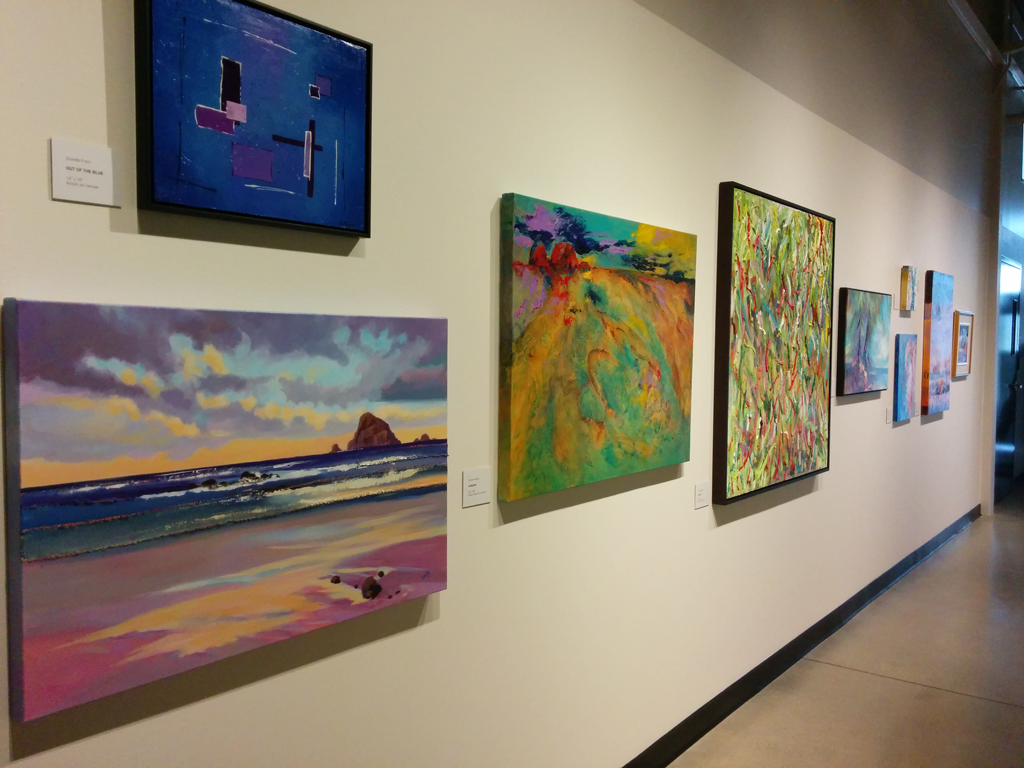By Ashley Mussbacher (The Cascade) – Email
Print Edition: May 7, 2014

The Reach Gallery and Museum is perfect for an early morning gander. I was the only patron in the building before 10 a.m., and I was grateful for it.
I’m embarrassed to admit I don’t visit art galleries as often as I should. I’m not one of those people who believes when you go to a gallery you must stare at each individual piece for hours on end until your brain turns to mush and drips out your ears. So, to break the status quo, I walk through a gallery at a leisurely pace, and I don’t stop. This show was different.
As soon as I entered the gaping mouth of the first room featuring Simone Jones’ multimedia piece All that is solid, I stopped. Transfixed. The entirety of the 36’-long wooden panel piece pulled me into the fish-eye view of a hallway with floating black and white geometric shapes cascading through the screen.
At first I thought: what gives? Then, slowly, with the ambience of the unnatural audio echoing through the room, I began to piece it together. Jones questions how we perceive time and space with the fish-eye view. It is a comment on our perception of reality through a digital realm — how more and more we desperately try to perceive what is real through what is not, attempting to bridge the disconnect. But we can’t. Ultimately, we cannot succeed in mixing something that is solid with something that is not.
But we can try.
I moved on even though my mind was still hung up on Jones’ ethereal piece, and was unexpectedly drawn toward Myrtle-Anne Rempel’s Passion in Abstract and Oriental Painting in Red, a burst of framed vibrancy. But it was the 14K gold leaf incorporated into the painting that made me stop again.
Although painted on separate canvases, the two are meant to be viewed with slightly blurred vision as one. I found that even though each painting had a focus point, if I started at the small gap between them, the softer charms came through the reds and really made the piece dynamic: tiny flecks of blue, white, and green; beads and ripples of texture; a pale sheet of music; some ornate wallpaper.
I had to pull myself away, or I would have stared for hours. With a dripping brain.
Nearby was more local work from the Fraser Valley Chapter of the Federation of Canadian Artists. Dusk by Janis Eaglesham is a representational landscape painting of a forest at dusk. What pulled my eye immediately were the birds in flight, and then I noticed the sun. I felt like it was being swallowed by the sky. The night pushes in from above. The shadows beyond the trees wait for the sun to descend. It’s haunting.
The next in that series that called to me was Out of the Blue by Suzette Fram. While this painting was reminiscent of cubist work, which I’m not a huge fan of, I loved the dynamic feel of the colours. I felt like I had been pulled into an ocean, dragged into the deep. Down, down, down with my eyes open. And yet, I was calm. I could drown and not give a damn.
Bill bissett’s exhibition shared a space with Leonard Frank’s photography exhibition, and I didn’t get much of a chance to walk through before I was dragged across the room to a three-panelled piece titled in first three fools.
It was their eyes. They inspired passion in me like no other painting had. I passionately disliked the three fools. The circles of their eyes horrified me into thinking I was about be sucked through them, only to come out the other side of the wooden panels empty, an emotionless void. I wanted to fill the spaces with my thoughts, but I was scared that it would leave me mindless. But the more I wanted to pull away from them, the stronger the three fools’ grip on me became.
The battle to get away was messy, and I don’t wish to relive it.
The Reach’s Leonard Frank exhibition was photography pulled purely from archives. Digitizing coordinator Tricia Taylor explained that the gallery still has over 60,000 negatives to be made into digitized photographs for the records.
“Many local people bring their negatives to us to donate,” she said. One photograph she recalled was of a large family with 15 siblings, black and white, which was on display with many other archived images. She explained an elderly couple visited the gallery and pointed out the photograph.
“It had been a part of a collection of photographs the women’s husband had put together as their 25th wedding anniversary, and was later lost to them in a flood many years ago. It was of all her siblings,” Taylor explained. “Of course we gave them a copy of the picture, and I’m sure they had quite the family reunion.”

